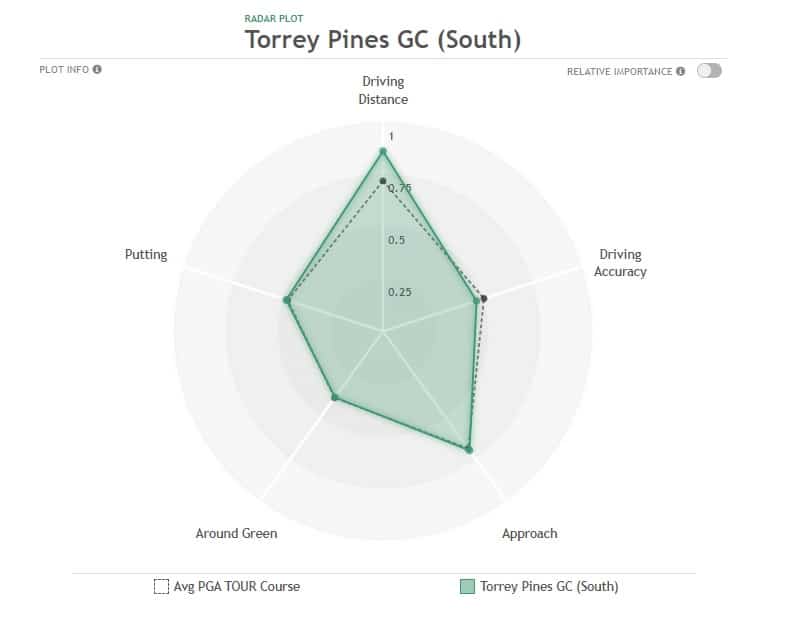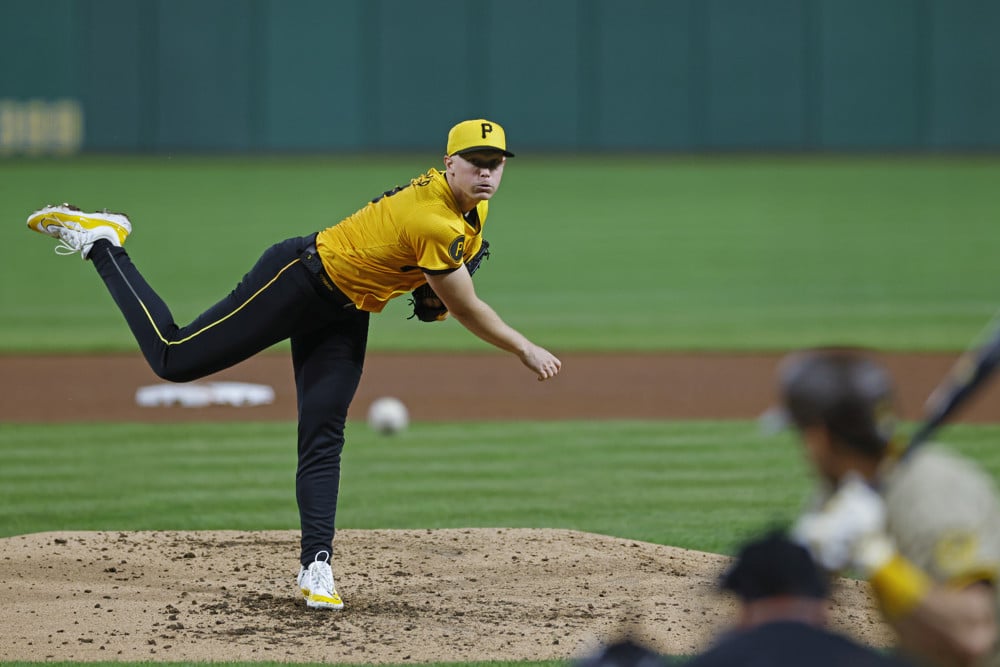The PGA Tour rolls on with its California swing in La Jolla! A strong field returns to one of the toughest golf courses on the schedule for the 2023 Farmers Insurance Open at Torrey Pines. As always, here is your early deep-dive of the 2023 Farmers Insurance Open and a preview of how to bet. In addition, listen below to the Golf Gambling Podcast for more information about golf betting.
2023 Farmers Insurance Open – The Field
For most casual fans, the Farmers Insurance Open marked the beginning of the PGA Tour season. This would be where Tiger Woods would make his debut. Other popular top players like Rory McIlroy, Dustin Johnson, Brooks Koepka would also make an appearance to add casual intrigue to this otherwise niche professional sports league.
But with the change in the schedule to designate certain events as “elevated”, the Farmers Insurance Open seems to be a slight casualty to the new world order on the PGA Tour. The 2023 Farmers Insurance Open, at least this year, did not receive elevated status. As such, while there are several top names in this field, the depth of it is not nearly what it once was.
Highlighting the field is Jon Rahm. Rahm is widely regarded as the King of Torrey Pines. His win on the PGA Tour came at Torrey Pines. And his lone major championship also came at Torrey Pines. Through 54 holes, Jon Rahm is tied atop the leaderboard at the 2023 American Express. Should he go on to win it, it wouldn’t be a surprise if he had odds as high as 5/1 to win at Torrey Pines once again.
Other notables in the field include Tony Finau, Max Homa, Sungjae Im, Hideki Matsuyama, Collin Morikawa, Xander Schauffele, Justin Thomas, and Will Zalatoris.
For the full field, click here.
2023 Farmers Insurance Open – The Golf Courses
Torrey Pines is a municipally owned golf course built in 1957 on the site of an old U.S. Army Base just north of San Diego. William Bell designed the golf course. It features two 18-hole tracks on the north and south sides of the property. The PGA Tour has made Torrey Pines a regular stop on the tour since 1968.
Starting in 2000, the U.S. Open began to have an appetite for municipal public golf courses in their effort to #growthegame. Along with fellow municipal golf course Bethpage Black, Torrey Pines was picked by the U.S. Open to host the 2008 event. They hired Rees Jones to redesign the golf course so that it was suitable for championship play.
The revisions to the South Course included a significant lengthening to counter advancements in golf technology. It also repositioned greens closer to the canyons to bring them into play. Finally, Jones added numerous fairway bunkers to challenge the professionals off the tee. The golf course is now a beast. From the tips, it plays as long as 7,800 yards.
I’ve spent several years breaking down the history and design of the South Course at Torrey Pines. And if you’ve read this column for the last few years, you know that I’m not a big fan of the golf course. So if you’d like to see those comments, click here.
But I’m not going to rehash all the negative comments. You’ve come here for information, not my opinion. So this section is primarily going to focus on the recent changes made to the golf course before the 2021 U.S. Open. This space will also discuss the differences in golf course setup between the Farmers Insurance Open and the U.S. Open.
First, let’s discuss some recent changes to the South Course. Over the last few years, Rees Jones made a few subtle changes to make Torrey Pines South. A few new tee boxes were added to make some holes play a little differently. A tightly mowed collection area was also added behind the 9th Green.
But the most significant change made to the golf course was with the fairway bunkers. Increased driving distances forced his hand. New fairway bunkers were added to make it more challenging off the tee. Bunkers were also shifted closer to fairways to allow balls to roll down into them. Every Par 4 and 5 on the golf course got some sort of bunker alteration. Either existing fairway bunkers were brought in closer to the fairway, or a new one was added to the landing zone.
The work to the first hole is a great example of this:
1st Hole – Before
1st Hole – After
The short bunker was moved up the fairway. It’s now 320 yards off the tee to the middle of that bunker. In addition, before the renovation, a small swath of rough provided a barrier between the bunker and the fairway. Balls that just trickled off the fairway could get caught up in the intermediate rough. Now, the fairway transitions to the bunkers themselves. There’s less margin for error off the tee now than there was before.
But while this increased the need to keep the ball in the fairway, that was always the case at Torrey Pines. The problem with this approach is that even for the more accurate guys, finding fairways at Torrey Pines is a difficult task. With fairways only averaging 28 yards wide, the driving accuracy % for this event is typically well below PGA Tour averages.
And even if a shorter player does find the fairways, the golf course is so long that they’re faced with long approach shots all tournament. That means fewer greens in regulations hit overall for them too. Unless they’re wizards on and around the green, these types of players are seriously behind the eight-ball at Torrey Pines South.
Who’s not behind the eight ball at Torrey Pines? Guys who love to hit drivers where everything is right out in front of them. Long and straight off the tee is so key at Torrey Pines. These guys can look ahead of them down the fairway, pick their target, and wail away. Given their faster club head speeds, they can hit a higher and more controlled ball fight into the green. And should they find the rough, they have the club head speed to hit it close to the green and get up and down for par.
Another difference between the U.S. Open and the Farmers Insurance Open is the agronomy. Naturally, this golf course has Kikuyu fairways with Bermuda rough. That’s the turf conditions at the U.S. Open. But the fairways and rough are overseeded with rye grass this week. While the rough is still plenty thick, it’s a little more forgiving because the ball can occasionally sit up in it. In Bermuda, it’s almost always going to sink to the bottom of the grass.
Lastly, the greens play a little slower for the Farmers Insurance Open than it will for the U.S. Open. The greens ran about 13.5 on the stimpmeter for the 2021 U.S. Open. For the Farmers Insurance Open, they’ll run closer to 12 or 12.5. That’s still faster than normal on the PGA Tour. And it’s much faster than what these players have seen for the last few weeks. It’ll be a big adjustment to navigate on these fast Poa Greens.
Three of four rounds of the Farmers Insurance Open are on the South Course, which is much longer than the North Course. Gamblers should make the South Course their primary focus for the week. But we can’t forget about the North Course though. Everyone will have to play that one either Thursday or Friday.
Tom Weiskopf redesigned the North Course in 2016. Weiskopf enlarged greens, removed eighteen bunkers (mostly of the fairway variety), and cut down dozens of trees due to a beetle infestation. While the removal of the trees disappointed some, it opened up the golf course significantly and gave way to spectacular views of the coastline.
The most beneficial change to the golf course was the simplest one. They decided to flip the nines so the Back Nine plays along the canyons and the Pacific Coastline. This provides a dramatic finale to a round and ensures a golfer walks off with fantastic memories, no matter how poorly they might play.
2023 Farmers Insurance Open – Betting Strategies
To start our preview of what betting strategies gamblers should have for the 2023 Farmers Insurance Open, let’s go over some historical stats and information about the North and South Course.
1. There are key differences between the South and North Courses. Per the GCSAA, the South Course will play 7,765 yards. The North Course, however, plays only 7,258 yards. Though each has similar course setups such as thick rough and narrow fairways, the shorter length of the North Course usually makes it play easier than its counterpart to the south.
Another difference is the greens. The greens on the South Course are poa annua. The North Course greens are bentgrass. The greens are also slightly larger than they are on the South.
One other note about the golf course set up concerns the rough. Typically, the overseeded rye rough is about 3″ in length. Due to the significant rainfall the last few weeks, the rough will be 3.5″ in length and be very thick. The soft golf course will also play tremendously long.
However, don’t expect the lengthened rough to change things all that much. 3 inches. 3.5 inches. 6 inches. Torrey Pines is going to play about the same no matter how long the rough is. It’s hard to change how a long, narrow, soft golf course will play. They all tend to play the same way.
2. Torrey Pines has the longest collection of Par 4’s and 5’s of all venues that have hosted at least 5 tournaments since 2015. The only non-major venue on the PGA Tour with longer Par 4’s and 5’s is Vidanta Vallarta at the Mexico Open (only one tournament in its history). Collectively, the Par 4’s and 5’s on the South Course at Torrey Pines average 486 yards in length.
3. The South Course is one of the toughest golf courses on the PGA Tour. Only PGA National plays tougher of all golf courses with at least five PGA Tour events since 2015. Historically, the South Course plays on average +1.14. And its Par 4’s are the toughest of all PGA Tour venues with at least five tournaments since 2015.
4. Of all non-major venues with at least five PGA Tour events since 2015, the South Course at Torrey Pines ranks as the 9th toughest off the tee. Though the golf course is right out in front of the player, the fairways are very narrow. The South Course features the second narrowest fairways on the PGA Tour. And there are usually fairway bunkers guarding both sides of the landing zone.
That explains why the average driving accuracy there is 60.6%. Only Silverado Resort, Quail Hollow and Riviera feature lower driving accuracy rates of all golf courses with at least five tournaments since 2015. The South Course is very demanding off-the-tee. And you must hit driver. There’s no way around it. Otherwise players will have well over 220 yards into most Par 4’s on the golf course.
5. Despite thick rough, there isn’t as much of a penalty to missing a fairway at the South Course as one might think. The penalty to missing a fairway is only slightly above average on the PGA Tour. And the difference in strokes gained from the fairway and out of the rough is about PGA Tour average too.
Why is that? For starters, even if one hits the fairway they face a long approach shot into a multi-tiered small green. That’s still a difficult approach shot where missing a green in regulation is certainly still in the cards. As such, it’s very likely that two golfers, one in the rough and one from the fairway, will both attempt to get up and down from off the green on the same hole.
6. The greens on the South Course are some of the toughest to putt on. Of all golf courses on the PGA Tour with at least five tournaments since 2015, these are its ranking in terms of difficulty:
- Putts < 5 feet: Toughest
- Putts 5-15 feet: Toughest
- Putts 15+ feet: 7th Toughest
The greens are in quadrants, making it difficult to get the ball close to the hole should one find themselves on the wrong level. And the poa is very tricky to putt on. This type of poa tends to be much bumpier and inconsistent than other poa annua strains on the PGA Tour. There’s more luck in putting on these greens than there might be on other golf courses. One wrong roll over the wrong bud of poa might send a perfect putt careening offline.
Next in the 2023 Farmers Insurance Open preview, let’s take a look at the relative skill set chart from DataGolf of what types of players Torrey Pines tends to favor:
It’s no surprise that there’s big correlation between length off the tee and success at Torrey Pines. Anytime a long golf course features tough to hit fairways, hitting it as far as possible presents a huge edge. And the ability to pull a shorter iron from long range is an edge at Torrey Pines. Either it gives one a higher ball flight to land it softly onto the proper tier, or the ability to gouge out of the thick rough easier than one would with a 5 iron.
As far as the rest of the skillset chart, there are slight positive correlations in approach, around the green and putting to success. A player who is long and hits their irons well do very well at Torrey. Same for a player who hits it long and is great around the green. Or someone who is long and putts tremendous on Poa. And when you get a player with 3+ of these elite skillsets (like a Luke List or Jon Rahm), that typically is a recipe for big success.
Now, is distance absolutely a pre-requisite to winning at Torrey Pines? No. We’ve seen shorter hitters like Patrick Reed and Brandt Snedeker win there. But they possess all-world abilities on and around the green. So if the weather conditions mean higher rates of missed greens in regulation for the field, a player like that can contend because they can get up and down all day without losing strokes to the field.
It should also be noted that the skillset chart for the North Course is quite similar to that of the South. Therefore, there’s no differences in skills gamblers need to take into account course to course.
Lastly, here is the approach shot distribution chart for the South Course at Torrey Pines:
About 68% of all approach shots will come from over 150 yards. And there’s about an even distribution on approach shots from 150-200 and 200+ Weight both buckets evenly in models and take into account if any golfer is really good or really bad in one of those ranges.
Follow these tips this preview, and gamblers can put together a solid betting card or DFS lineup for the 2023 Farmers Insurance Open.




























